Assessment on Diversity and Abundance of Araceae in Limestone and Pyroclastics Areas in Gua Musang, Kelantan, Malaysia
DOI:
https://doi.org/10.47253/jtrss.v1i1.665Keywords:
Araceae, limestone, pyroclastics, diversity, abundance, topography, geographyAbstract
The study was conducted in Gua Musang, Kelantan, namely; Kuala Koh N 04° 52’ 02.2”/ E 102° 26’ 33.3” (represents pyroclastics area) and Tanah Puteh N 04° 46’ 11.9”/ E 101° 58’ 35.5” (represents limestone area). A square plot (100 x 100 m) was set-up in both locations for sampling of Araceae. The result shows diversity of Araceae in limestone (28 species ha-1 ) is higher as compared to pyroclastics area (21 species ha-1). The most abundant species in limestone are Anadendrum microstachyum, Homalomena griffithii, Rhaphidophora tenuis and Schismatoglottis brevicuspis. In pyroclastics area, the most abundant is S. calyptrata followed by, S. scortechinii, S. brevicuspis and A. microstachyum. The common species in both areas was hemiepiphytic R. mangayi. The least abundant species in limestone are Amorphophallus sp. and Homalomena Chamaecladon Supergroup. Meanwhile, Scindapsus perakensis, Homalomena Cyrtocladon Supergroup, H. pontederiifolia and Aglaonema simplex were counted as least abundant species in pyroclastics area. Geological features, topography (whether on-slope, on-ridge or edge of stream), and altitude are the most influencing factor on distribution and abundance of aroids species.







